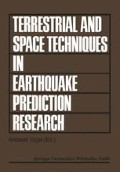Summary
We study the topological properties of three types of networks formed with stations at the vertices of systems of squares, of equilateral triangles and regular exagones. The length of the sides necessary to locate a generically located event of given magnitude are computed. The type of network covering a given region and detecting events of given magnitude from a minimum number of stations is determined. The magnitude which minimizes the ratio between the number of stations and the number of events surveyed is determined for each type of network. The formulae are applied to the USA and Italy. The re: suits can be applied to any network of sensor devices aimed to detect physical or biological or geophysical phenomena.
Access this chapter
Tax calculation will be finalised at checkout
Purchases are for personal use only
Preview
Unable to display preview. Download preview PDF.
References
Kijko A., Methods of the optimal planning of regional seismic networks, Polish Ac. Sc.Inst. Geoph., A-7 (119), 1978.
Kijko A., An analysis of the optimum extension of the regional seismic network in upper Silesia, Acta Geophys. Polonica, XXIV,3, 205–215, 1976.
Kijko A., An algorithm for the optimum distribution of a regional seismic network I. Pageoph, 115, 999–1009, 1977.
Kijko A., An algorithm for the optimum distribution of a regional seismic network II, Pageoph, 119, 1011–1021, 1977.
Caputo M., A mechanical model for the statistics of earthquakes magnitude moment and fault distribution. Bull. Seismol. Soc. Am. 67,3, 849–861, 1977.
Caputo M., Model and observed seismicity represented in a two dimensional space. Annali di Geofisica XXIX, 4, 2))-288 1976.
Caputo M., Sulla configurazione delle curve algebriche sghem be dei primi ordini dotate di D⪖ 0 punti doppi, situate sopra quadriche. Annali Università di Ferrara, Scienze Matematiche Vol.1, n,12, 1952.
Author information
Authors and Affiliations
Editor information
Rights and permissions
Copyright information
© 1979 Springer Fachmedien Wiesbaden
About this chapter
Cite this chapter
Caputo, M. (1979). Topology and Detection Capability of Seismic Networks. In: Vogel, A. (eds) Terrestrial and Space Techniques in Earthquake Prediction Research. Vieweg+Teubner Verlag, Wiesbaden. https://doi.org/10.1007/978-3-322-86323-2_3
Download citation
DOI: https://doi.org/10.1007/978-3-322-86323-2_3
Publisher Name: Vieweg+Teubner Verlag, Wiesbaden
Print ISBN: 978-3-528-08406-6
Online ISBN: 978-3-322-86323-2
eBook Packages: Springer Book Archive

